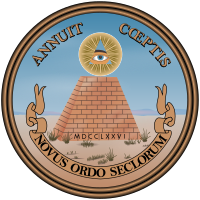Novus ordo seclorum
The phrase Novus ordo seclorum (Latin for "New order of the ages") appears on the reverse of the Great Seal of the United States, first designed in 1782 and printed on the back of the United States one-dollar bill since 1935. The phrase also appears on the coat of arms of the Yale School of Management, Yale University's business school. The phrase is sometimes mistranslated as "New World Order" by people who believe in a conspiracy behind the design.[1]

Origin and phrase meaning
The phrase is taken from the fourth Eclogue of Virgil,[2] which contains a passage (lines 5-8) that reads:
| Latin | English |
|---|---|
| Ultima Cumaei venit iam carminis ætas; | Now comes the final era of the Sibyl's song; |
| Magnus ab integro sæclorum nascitur ordo. | The great order of the ages is born afresh. |
| iam redit et Virgo, redeunt Saturnia regna, | And now justice returns, honored rules return; |
| iam nova progenies cælo demittitur alto. | now a new lineage is sent down from high heaven. |
The forms saecla, saeclorum etc. were normal alternatives to the more common saecula etc. throughout the history of Latin poetry and prose. The form saeculorum is impossible in hexameter verse: the ae and o are long, the u short by position. For the medieval exchange between ae, æ and e, see Æ; the word medieval (mediæval) itself is another example.[3]
Medieval Christians read Virgil's poem as a prophecy of the coming of Christ. The Augustan Age, although pre-Christian, was viewed as a golden age preparing the world for the coming of Christ. The great poets of this age were viewed as a source of revelation and light upon the Christian mysteries to come.[4]
The word seclorum does not mean "secular", as one might assume, but is the genitive (possessive) plural form of the word saeculum, meaning (in this context) generation, century, or age. Saeculum did come to mean "age, world" in late, Christian Latin, and "secular" is derived from it, through secularis. However, the adjective "secularis," meaning "worldly," is not equivalent to the genitive plural "seclorum," meaning "of the ages."[5]
Thus the motto Novus ordo seclorum can be translated as "A new order of the ages." It was proposed by Charles Thomson, the Latin expert who was involved in the design of the Great Seal of the United States, to signify "the beginning of the new American Era" as of the date of the Declaration of Independence.[6]
See also
References
- ^ "Novus Ordo Seclorum - Origin and Meaning of the Motto Beneath the American Pyramid". GreatSeal.com.
- ^ "Source of NOVUS ORDO SECLORUM". GreatSeal.com.
- ^ See declension of the second declension noun saeculum (or saeclum in its poetic form) at http://en.wiktionary.org/wiki/saeculum
- ^ Ann Raftery Meyer: Medieval allegory and the building of the new Jerusalem DS Brewer, 2003. ISBN 978-0-85991-796-4
- ^ Lewis and Short, A Latin Dictionary: Founded on Andrews' Edition of Freund's Latin Dictionary: Revised, Enlarged, and in Great Part Rewritten by Charlton T. Lewis, Ph.D. and Charles Short, LL.D. The Clarendon Press, Oxford, 1879, s. vv.
- ^ "Novus Ordo Seclorum - Origin and Meaning of the Motto Beneath the American Pyramid". GreatSeal.com.
